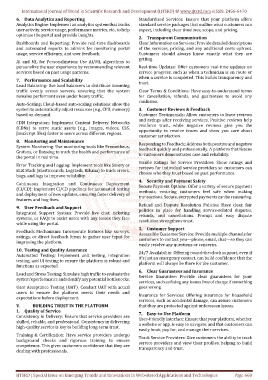Page 670 - Emerging Trends and Innovations in Web-Based Applications and Technologies
P. 670
International Journal of Trend in Scientific Research and Development (IJTSRD) @ www.ijtsrd.com eISSN: 2456-6470
6. Data Analytics and Reporting Standardized Services: Ensure that your platform offers
Analytics Engine: Implement an analytics system that tracks standard service packages that outline what customers can
user activity, service usage, performance metrics, etc., to help expect, including clear timelines, scope, and pricing.
optimize the portal and provide insights.
2. Transparent Communication
Dashboards and Reporting: Provide real-time dashboards Clear Information on Services: Provide detailed descriptions
and automated reports to admins for monitoring portal of the services, pricing, and any additional costs upfront.
usage, service efficiency, and user feedback. Customers should always know exactly what they are
getting.
AI and ML for Personalization: Use AI/ML algorithms to
personalize the user experience by recommending relevant Real-time Updates: Offer customers real-time updates on
services based on past usage patterns. service progress, such as when a technician is en route or
when a service is completed. This builds transparency and
7. Performance and Scalability trust.
Load Balancing: Use load balancers to distribute incoming
traffic evenly across servers, ensuring that the system Clear Terms & Conditions: Have easy-to-understand terms
remains performant even under heavy traffic. for cancellation, refunds, and guarantees to avoid any
confusion.
Auto-Scaling: Cloud-based auto-scaling solutions allow the
system to automatically adjust resources (e.g., CPU, memory) 3. Customer Reviews & Feedback
based on demand. Customer Testimonials: Allow customers to leave reviews
and ratings after receiving services. Positive reviews help
CDN Integration: Implement Content Delivery Networks reinforce trust, while negative reviews give you the
(CDNs) to serve static assets (e.g., images, videos, CSS, opportunity to resolve issues and show you care about
JavaScript files) faster to users across different regions.
customer satisfaction.
8. Monitoring and Maintenance Responding to Feedback: Address both positive and negative
System Monitoring: Use monitoring tools like Prometheus, feedback quickly and professionally. A platform that listens
Grafana, or Datadog to track the health and performance of to customers demonstrates care and reliability.
the portal in real time.
Visible Ratings for Service Providers: Show ratings and
Error Tracking and Logging: Implement tools like Sentry or reviews for individual service providers so customers can
ELK Stack (Elasticsearch, Logstash, Kibana) to track errors, choose who they trust based on past performance.
bugs, and logs to improve reliability.
4. Security and Payment Safety
Continuous Integration and Continuous Deployment Secure Payment Options: Offer a variety of secure payment
(CI/CD): Implement CI/CD pipelines for automated testing methods, ensuring customers feel safe when making
and deployment of new updates, ensuring faster delivery of transactions. Secure, encrypted payments can be reassuring.
features and bug fixes.
Refund and Dispute Resolution Policies: Have clear, fair
9. User Feedback and Support policies in place for handling service-related disputes,
Integrated Support System: Provide live chat, ticketing refunds, and cancellations. Prompt and easy dispute
systems, or FAQs to assist users with any issues they face resolution strengthens trust.
while using the portal.
5. Customer Support
Feedback Mechanisms: Incorporate features like surveys, Accessible Customer Service: Provide multiple channels for
ratings, or direct feedback forms to gather user input for customers to contact you—phone, email, chat—so they can
improving the platform.
easily resolve any questions or concerns.
10. Testing and Quality Assurance 24/7 Availability: Offering round-the-clock support, even if
Automated Testing: Implement unit testing, integration it’s just an emergency contact, can build confidence that the
testing, and UI testing to ensure the platform is robust and platform will always be there for the customer.
functions as expected.
6. Clear Guarantees and Insurance
Load and Stress Testing: Simulate high traffic to evaluate the Service Guarantee: Provide clear guarantees for your
system's performance and identify any potential bottlenecks.
services, such as fixing any issues free of charge if something
User Acceptance Testing (UAT): Conduct UAT with actual goes wrong.
users to ensure the platform meets their needs and Insurance for Services: Offering insurance for household
expectations before deployment.
services, such as accidental damage, can assure customers
V. BUILDING TRUST IN THE PLATFORM that they are protected against unforeseen issues.
1. Quality of Service 7. Easy-to-Use Platform
Consistency in Delivery: Ensure that service providers are User-Friendly Interface: Ensure that your platform, whether
skilled, reliable, and professional. Consistency in delivering a website or app, is easy to navigate, and that customers can
high-quality service is key to building long-term trust.
easily book, pay for, and manage their services.
Training & Certification: Have service providers undergo Track Service Providers: Give customers the ability to track
background checks and rigorous training to ensure service providers and view their profiles, helping to build
competence. This gives customers confidence that they are transparency and trust.
dealing with professionals.
IJTSRD | Special Issue on Emerging Trends and Innovations in Web-Based Applications and Technologies Page 660

